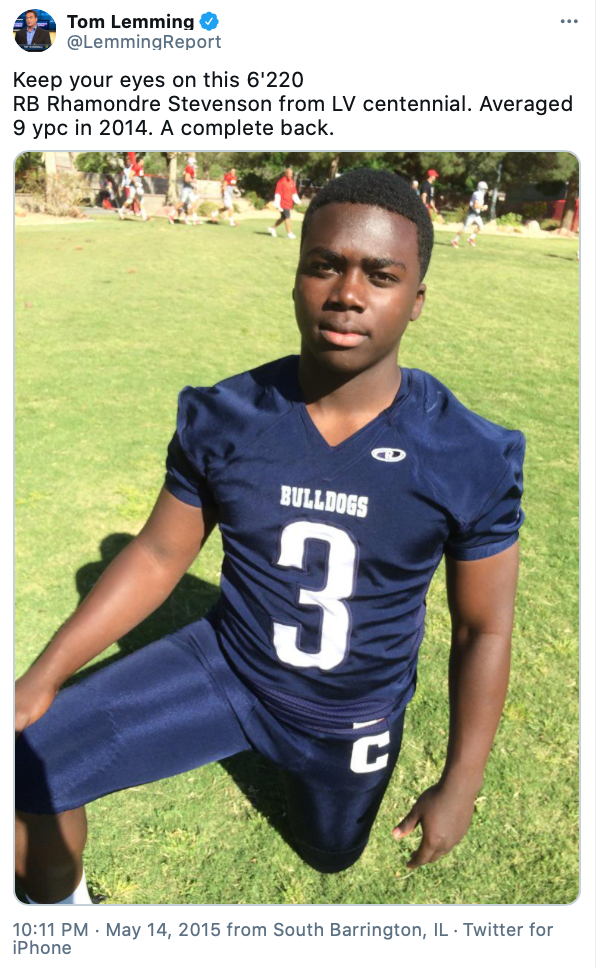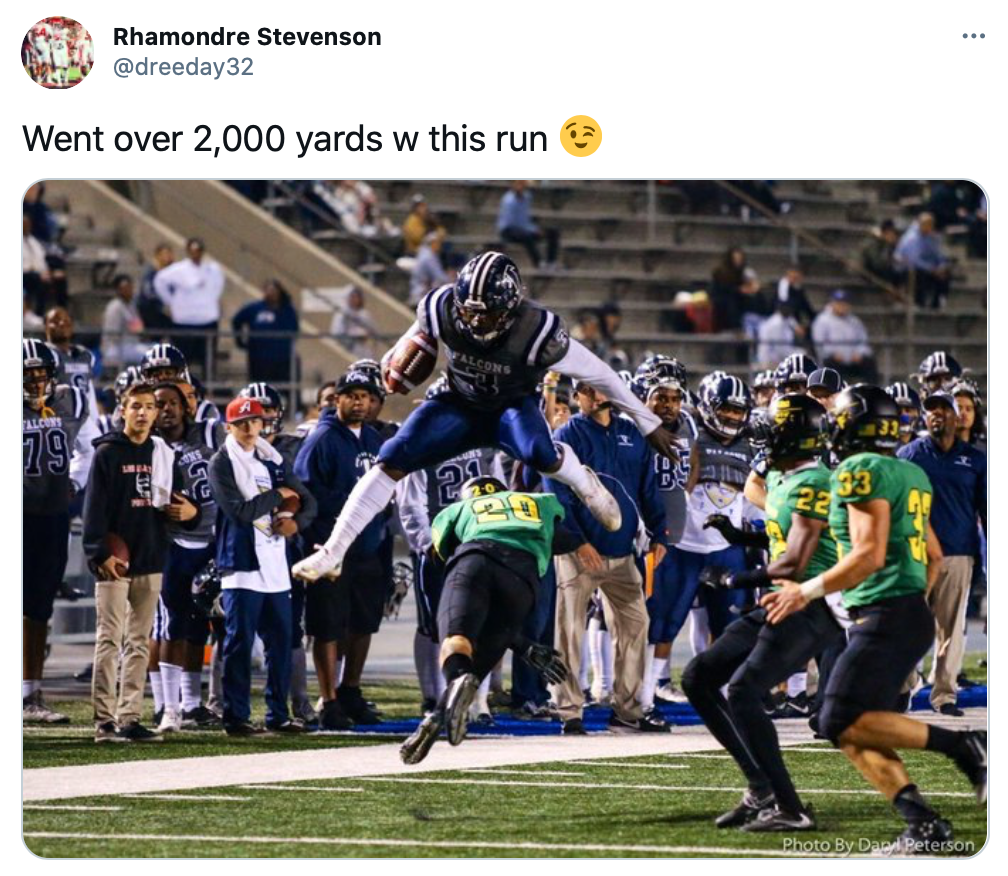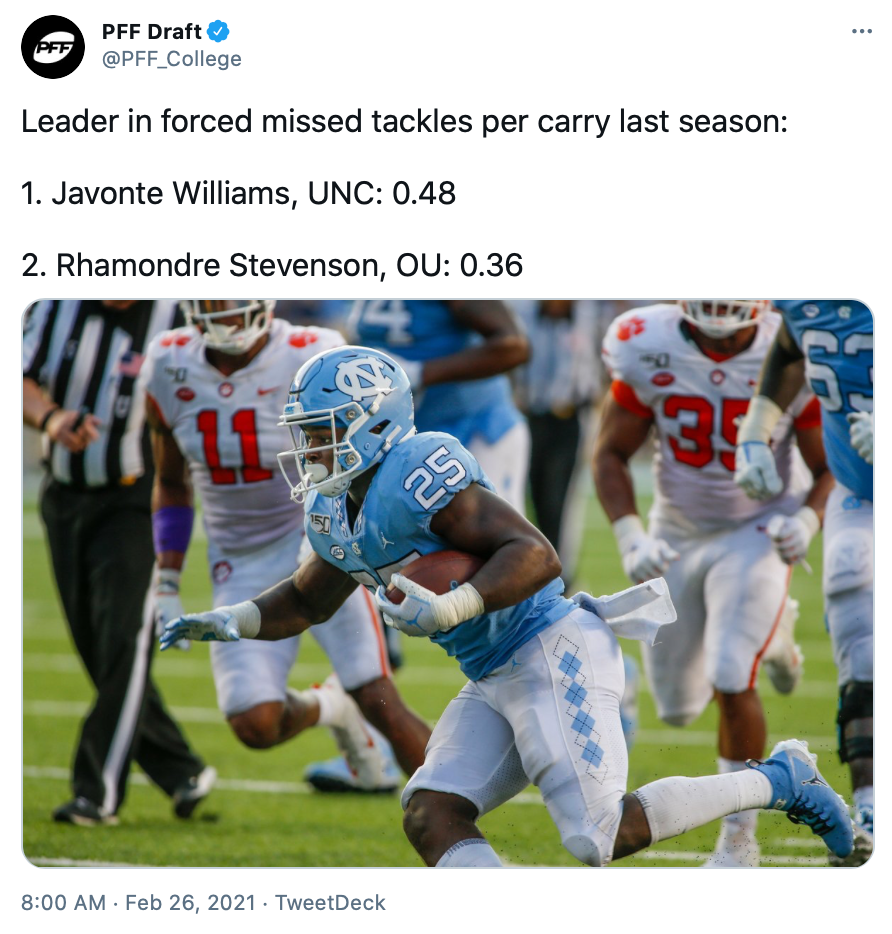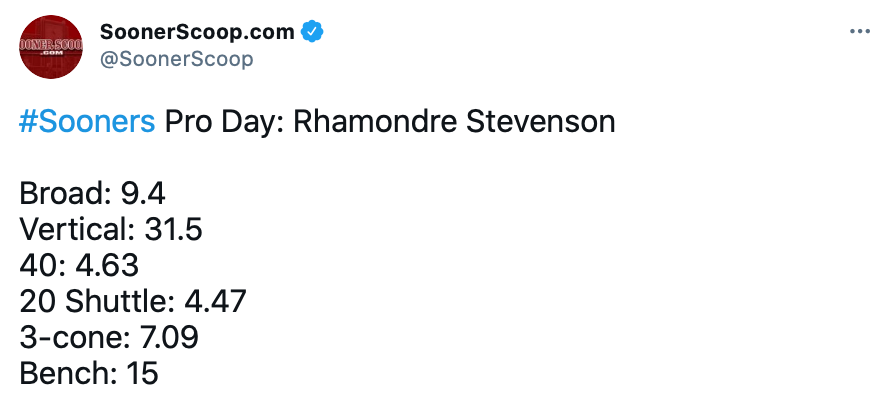Rhamondre Stevenson
RB | Oklahoma Sooners | 6-0 | 227 lbs.
The Story
Rhamondre Stevenson is certainly a big kid, just not quite as big as the near “250-pounder” some in the media have speculated him to be. Stevenson definitely wouldn’t complain with being mentioned in the media for what he proves on the field. With various reasoning, his career has been nearly derailed by his activities off the field. By the time this Las Vegas, Nevada kid reached high school as a freshman, he was already 6-foot, 200 pounds. Throughout his early football career, he was always massive for his age. By his junior year, he would see the lion’s share of the backfield carries at Centennial High School. He responded with 1,457 rushing yards, 17 TDs, and 238 receiving yards. “Dre Day” was selected as First Team All-State.
Stevenson already had scholarship offers from BYU and Middle Tennessee after that junior season. Then reality slapped him right across the face. He broke his foot in the third game of his senior season. Not only that, news reached him that the 2.0 GPA required to play HS football in Nevada he’d maintained would not be good enough to play football in the NCAA. Since he flunked his math and English classes his freshman year, Stevenson would need to work triple-time to right the ship. He actually moved in — along with several other football athletes — with a former high school coach who helped football players rehabilitate their academic issues combined with a training regimen.
Stevenson returned to the field a little over a month later to face Centennial’s heated rivals, Arbor View. But he wound up gaining only eight yards on eight carries, fumbling three times in the 17-14 defeat. And, despite his best efforts, he fell short of getting his GPA up to a 2.3. That defeat, three fumbles, would be the last time Stevenson would play football for 11 long months. Stevenson referred to that time in his life as a “reality check” and that he “honestly thought [his] football career was over.” After clearing his head of all doubts, he would be forced to look outside of the NCAA schools to continue his career.
Cerritos Community College normally doesn’t recruit outside of the state of California. Stevenson’s first HC at Cerritos, Frank Mazzotta, said “all I know is he showed up, it was just a great surprise for us.” And, looking back on Rhamondre’s first season, Mazzotta admitted he should’ve played him more. Stevenson ran for 501 yards, three TDs while splitting time with three other RBs during his true freshman season in Norwalk. But his curtain call would place him on the fast-track to NCAA play. With a new HC at Cerritos in Dean Grosfeld, Stevenson claimed 50% of the backfield for himself. He would end the season with 2,111 rushing yards with 16 TDs.
The impressive rushing total broke the 27-year old Cerritos CC record set by Darrell Thompson (1,527), ranks second all-time in NJCAA history behind Georgia Military’s Jovon Robinson, and sixth-best in national history. It didn’t take long for NCAA schools to start chasing after Stevenson. USC, Texas, Kansas State, BYU, Southern Miss, Hawaii, and Middle Tennessee were in hot pursuit. But Stevenson already made it clear in his Cerritos bio that he “would like to transfer to the University of Oregon, Ole Miss, University of Oklahoma or Florida State University.” When Jay Boulware, former RB coach/recruiting director at Oklahoma, came calling, Stevenson immediately signed.
OU HC Lincoln Riley and Boulware were on the lookout for a big, bruising RB to pair with the talents of Trey Sermon and Kennedy Brooks. Boulware got one look at Stevenson’s tape, and noticed “he has some suddenness to him. He doesn’t move like a 231-pounder.” And Stevenson justified those statements when he ran for 515 yards with 8.0 YPC and 5.9 yards after contact/attempt (YAC/Att) over 64 carries in 2019. But the season for Stevenson would end early when he took an NCAA-administered test that flagged him positive for marijuana use along with Sooners’ WR Trejan Bridges and Edge Ronnie Perkins prior to the 2019 Peach Bowl against LSU. They were each handed six-game bans, and Stevenson wouldn’t play football… for another long 11 months.
The Attributes
Between the broken foot and failing to qualify for NCAA participation, Stevenson would obviously go unranked by the scouting outlets. But, following community college, Rhamondre was rated as the JUCO RB1 by both ESPN and 247Sports. During his pre-college testing, Stevenson recorded a 4.64 second 40-yard dash, 4.30 short shuttle, and 29.3 inch vertical jump. With the benefit of his Oklahoma Pro Day behind us, we know that previous 40-time was legit with the 4.63 recorded on March 12. Even though his short shuttle dropped to 4.47, it’s still not at major red flag levels. His 31.5 inch vertical, 112 inch broad jumps do suggest limitations in his lower-body explosiveness. But his 7.02 second 3-cone time certainly caught my attention. Placing him into the 60th percentile, the three-cone tells us his acceleration while changing direction is at an NFL level.
If you’d like to check out his monster sophomore season at Cerritos, here is a link to some highlights. It’s definitely worth checking out. But we’ll get started with highlights from his first season at Oklahoma. As always, I do recommend that you watch at least three or four full games in order to evaluate any player, including Stevenson. To get you started, here are links to full games from the entire 2019 season:
Houston | South Dakota | at UCLA | Texas Tech | at Kansas | at Texas | West Virginia | Iowa State | at Baylor | TCU | at Oklahoma State | Baylor (B12 CC)
On his very first carry wearing Crimson and Cream, Stevenson coughed the football up after a two-yard gain. But he would rebound to have a stellar season as the third-wheel in the RB rotation. co-OCs Cale Gundy and Bill Bedenbaugh’s offensive scheme would incorporate Inside and Outside Zones with Gap blocking (Counter and Power) in 2019. Nobody has utilized Counter blocking — two pulling blockers from the backside — more in the FBS since the day Lincoln Riley came to Norman. We see our first example at 3:10 in the video. Notice the subtle hesitation from Stevenson allowing his pulling O-linemen to set their blocks before making his cut. It’s simply vital that the RB allows his pulling, 275-plus-pound blockers to knock their defenders out of his lane in order to maximize Gap scheme results.
Stevenson would average 7.2 YPC on 13 attempts with Counter blocking. He would reach paydirt on one of those attempts, shown at 4:02 in the video. On this example, Baylor’s Henry Black doesn’t bite on the speed out route by left H-back Jeremiah Hall. Instead, he splashes upfield ahead of RG Tyrese Robinson, forcing Stevenson to abbreviate his attack -- still hitting his designed left A-gap -- into the end zone. It’s a clear example of Stevenson using his impressive change of direction (COD) recorded in his Pro Day 3-cone. After Counter, the Sooners used Inside Zone (IZ) blocking as their secondary concept choice.
Zone blocking concepts are different from their Gap counterparts in that they are designed to block general areas along the D-line for the RB to choose his optimal gap. The best Zone RBs will simultaneously use their vision to identify-and-attack a lane, hence the moniker “one-cut RB.” On just over a third of his 64 attempts, Stevenson scored a pair of TDs with IZ blocking. Let’s first view the example at 2:01 in the video. I can’t help seeing some similarities in Stevenson’s game with former Texas Longhorns, Saints, and Dolphins RB Ricky Williams. Rhamondre identifies his right A-gap, sheds a couple tackles, and uses every bit of his speed to cross the goal line. The other TD on IZ blocking is back at 1:01 in a goal-to-go (G2G) situation. You know the RB has done his job in a G2G with IZ blocking when he simply walks into the end zone.
At 2:34, the Longhorns bite horribly on the Jet Sweep fake by CeeDee Lamb. It allows the OU O-line to work to the second-level of the defense as if it were a designed screen. On the very next play (2:45), we see how elusive Stevenson is in space. Dating all the way back to his first football experience, “Dre Day” has been viewed as “big.” In those days, he was bigger than anyone on the field. In college, linemen are the biggest, but Stevenson is a “big” RB. It’s always allowed him to fool defenders who think the “big” label packs along “slow” and “clumsy” traits. Texas’ primary contain on this play learned the hard way that Stevenson is far from slow and clumsy. This play is a precise example of why 40-times for RBs are simply non-factors… that is, unless they are really good.
Something I want you to notice from the IZ run at 3:34 is how Jalen Hurts opens up the field for Stevenson. When the Eagles replaced Carson Wentz with Hurts this past season, it had a similar effect for Miles Sanders. Using the read-option, Hurts not only draws left Edge James Lynch, but Will LB Jordan Williams is also left flat-footed a full three-yards from Stevenson as he hits the right A-gap. Forcing a team’s defensive backs onto an island with a RB the size of Stevenson is a worst-case scenario. Our final IZ run in the video can be found on the next clip at 4:02. And it’s an exact replica of the events in the previous play. Hurts draws so much attention away from Stevenson that the right B-gap is seven-yards wide.
Stevenson averaged his fewest YPC (6.9) from Oklahoma’s three major concepts with Outside Zone (OZ) blocking, but also where he averaged his highest YAC/Att (6.3). With OZ blocking, the O-line will always block the defender in front of them, and depending on whether they are “covered” or not. But you’ll see the frontside of the O-line step a bit further laterally, attempting to “reach” to place his body between his assignment and the sideline. The RB will have his hips nearly parallel to the O-line, aimed at the second playside defender away from center along the D-line. The first example with OZ blocking is shown on the opening clip (0:00). It offers another perfect example of Stevenson’s ability to chain together his COD and acceleration.
The Kansas defense obviously didn’t get the memo before the run at 1:35 that it’s a very bad idea to attempt to tackle Stevenson high. Stevenson scored a pair of TDs with OZ blocking on only 18 attempts. The first is shown at 0:15. With the size of the lanes opened up by the OU O-line, Stevenson is able to make his first cut early. In the NFL, we will want to see him wait to make that cut until he is on the heels of his O-line. That will force LBs to fill their assigned gaps, allowing the RB to identify the gap left unattended. His second TD run can be found at 0:42. The one reception from Stevenson is shown at 1:21, a designed screen on a flare showcasing his elusiveness, once again.
Jumping ahead to his 2020 footage, Stevenson missed the first five games in order to fulfill a marijuana suspension. You can find the full-footage to each game Stevenson played below:
at Texas Tech | Kansas | Oklahoma State | Baylor | at Iowa State | Florida (BG)
With Hurts in the NFL, Trey Sermon transferring to Ohio State, and Kennedy Brooks opting out, Stevenson would go from an 18% backfield share to 50%. DeMarco Murray replaced Boulware as RBs coach, and the offense would increase Counter blocking by 15%, IZ blocking by 19%, and cut Power blocking in half. Spencer Rattler doesn’t gain the attention of Hurts with his rushing ability, but he’s athletic enough that defenses still need to stay honest. Stevenson would score nearly a third of his TDs with 9.3 YPC with Rattler on run-pass options (RPOs). We have a perfect example with Counter blocking at 1:19.
Rhamondre would continue to shred defenses with Counter blocking, accounting for 7.5 YPC, and an increase of 23% in YAC/Att over the previous season. All three of his Counter TDs are shown at 0:30, 1:10, and 4:53. You can find additional Counter blocking showing off Stevenson’s abilities at 2:42, 3:47, 4:12, 4:21, 4:31, and 4:45. We can see all four TDs Stevenson scored with IZ blocking at 1:37, 2:36, 2:50, and 3:04 in the reel. The scores at 1:37 and 2:50 highlighting how much damage Stevenson applies to defenders at the goal line. It’s that kind of toughness that will guarantee Stevenson the role as the goal line back in the NFL. Additional IZ runs can be located at the 0:52, 1:03, and 4:02 marks.
With his bruising size, a blind “downhill” label may get tossed around. Not with Stevenson’s footwork. And he’s shown his acceleration must have the proper accounting. Look no further than his work on OZ at 1:58, 2:12, 2:27, and 3:16 where his lateral work goes far beyond a “downhill” limitation. He’s not going to race past CBs to the sideline, but he’s far more agile than expected. To close out his rushing examples on the video, his acceleration is on full-display with Power blocking at 2:57 and 3:53. With only a single pulling blocker, Stevenson isn’t required to remain as patient before hitting his high gear.
We also see 8-of-18 receptions from the 2020 season in the video, five of which (0:19, 0:44, 1:29, 3:08, and 3:33) are on designed screens. Over half of his catches had that intended blocking in front of him. Without that screen blocking leading the way over his career, Stevenson’s yardage/route plummeted by 80%! That’s a concern for his future as a three-down back. We do have non-screen examples at 1:44, 2:04, and 2:20. But Rhamondre doesn’t carry his arsenal of running weaponry over to his receiving work.
Fantasy Fit
Despite his size, Stevenson is just as dangerous off the edges as he is between the tackles. He also did his best work with a 40% career bump in YPC behind 11-personnel over heavy sets. We can account for that improvement with his unexpected work off the edges. He’s more than a handful at the goal line, and punishes DBs with athletic QBs drawing LB attention away on RPOs. Stevenson would be the perfect fit for the Ravens’ Counter-, RPO-heavy rushing attack with Lamar Jackson. But that would not be an optimal landing spot for his early-work potential behind J.K. Dobbins and Gus Edwards. So, the Cardinals and Seahawks stand out for their athletic QBs, mix of Counter, OZ, and IZ concepts, and use of RPOs.
The Bottom Line
As previously mentioned, I see a lot of Ricky Williams in Stevenson’s game. The major difference between the two is a big difference in lower-body explosiveness. “Little Earl” tested out with a 37-inch vertical and 124-inch broad jump at the 1999 NFL Combine. Stevenson only gave us 31.5 and 112 inches at his recent Pro Day. Williams also had 17 pounds on Rhamondre. In spite of Williams’ counting stats as a receiver, he was never very efficient with the passing game work. Stevenson is also skilled in pass protection, another of Williams’ qualities. Both punished opposing defenders, but Stevenson appears to have Williams bested working after first contact.
It’s the receiving work that doesn’t pop off the screen from Stevenson for me. That part of his game doesn’t seem as natural. As with Williams and Derrick Henry, Stevenson could always fall into a situation where he sees enough receiving volume to make a difference. But it would be unwise to expect that production from his drafting team. What I do fully expect is that Stevenson’s rushing ability will be an asset in the NFL. Since his pass protection is already a plus, we can expect that he’ll get a touch of receiving work to go with his role as the goal line back.
Stevenson falls just outside of my third-tier of RBs (Javian Hawkins, Michael Carter, and Kenneth Gainwell) as my RB8 in front of Chuba Hubbard and Jaret Patterson. Sans Superflex formats, you’ll want to be considering Stevenson after the top-15 WRs, and before the seal is broken on the QBs in your rookie drafts.














